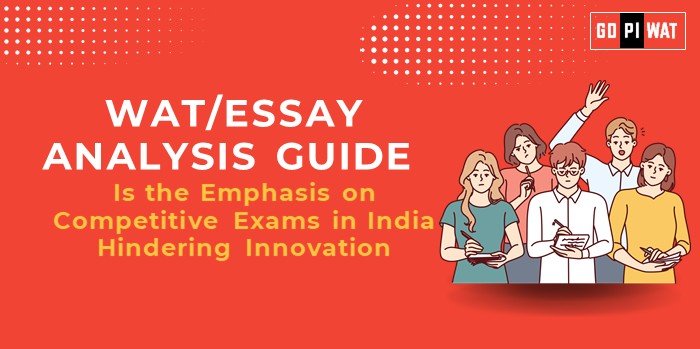📋 Is the Emphasis on Competitive Exams in India Hindering Innovation?
🌐 Written Ability Test (WAT) Analysis Guide
💡 Understanding the Topic’s Importance
Context: The debate on competitive exams ties directly to leadership, innovation, and education policy. It raises critical questions about India’s readiness for a knowledge-driven economy and its ability to foster creativity alongside academic excellence.
⏳ Effective Planning and Writing
- 🕒 Time Allocation:
- 📝 Planning: 5 minutes
- ✍️ Writing: 20 minutes
- 🔍 Review: 5 minutes
💬 Introduction Techniques for Essays
- ⚖️ Contrast Approach: “India’s students excel in academic contests but often lack the creative problem-solving skills necessary for innovation. The competitive exam system, though rigorous, may inadvertently hinder original thinking.”
- 🔧 Solution-Oriented Approach: “Balancing competitive exams with innovation-centric reforms can unlock India’s creative potential, a key to global leadership.”
📊 Structuring the Essay Body
🏆 Achievements:
- 📚 Meritocracy: Competitive exams have propelled students into prestigious institutions like IITs and IIMs, ensuring academic rigor.
- 🌍 Global Recognition: India’s graduates, especially in STEM fields, are highly valued worldwide.
⚠️ Challenges with Comparative Analysis:
- 🎓 Creativity Deficits: Overemphasis on rote memorization stifles critical thinking and problem-solving skills.
- 💡 Mental Health: Exam pressure contributes to stress and mental health issues among students.
- 🌍 Global Models: Finland prioritizes creativity through project-based learning, while China balances exams with innovation-driven reforms.
🚀 Future Outlook:
- 📚 Reforms: Introduce project-based assessments and interdisciplinary learning to nurture creativity alongside academics.
- 🌐 Global Learning: Adopt policies inspired by Finland’s holistic education and China’s focus on innovation and scale.
- 💻 Tech Integration: Use technology to foster innovation through interactive, problem-solving platforms.
✅ Concluding Effectively
- ⚖️ Balanced Perspective: “Competitive exams are essential for meritocracy but must evolve to include innovation-driven learning that fosters creativity and adaptability.”
- 🌍 Global Comparison: “India’s exam-focused approach requires the flexibility of Finland and the scale of China to thrive in the innovation age.”
📝 Sample Short Essays
🔹 Balanced Perspective (100 words):
Competitive exams have propelled millions into prestigious careers, ensuring meritocracy and academic excellence. However, their focus on rote memorization hampers innovation, a vital skill in today’s economy. Integrating project-based assessments and fostering creativity alongside academic rigor can create a balanced education model. By learning from Finland’s holistic approach and China’s reforms, India can maintain its academic excellence while nurturing innovators for the global stage.
🔹 Solution-Oriented (100 words):
India’s over-reliance on competitive exams risks stifling innovation. Reforming the system to include creativity-focused projects and extracurricular initiatives is vital. Introducing interdisciplinary assessments and reducing rote emphasis can foster critical thinking and problem-solving. Policies inspired by global leaders like Finland and China can help India build an education model that balances academic rigor with innovative growth, ensuring long-term global competitiveness.
🔹 Global Comparison (100 words):
India’s exam-centric education stands in stark contrast to Finland’s creative-first approach and China’s balanced model. While competitive exams have ensured academic excellence, they fail to foster innovation, a critical skill for global leadership. To bridge this gap, India must integrate reforms like interdisciplinary learning, creative projects, and stress management, creating a future-ready education system that matches global benchmarks. By doing so, India can balance its strengths in academia with the demands of a knowledge-driven economy.
📊 Key Takeaways
- 📈 Competitive exams ensure meritocracy but overemphasize rote learning.
- 🛠️ Reforms like project-based assessments and global benchmarking can nurture innovation.
- 🌍 Global education leaders like Finland and China provide successful models of balancing academic rigor with creativity.


